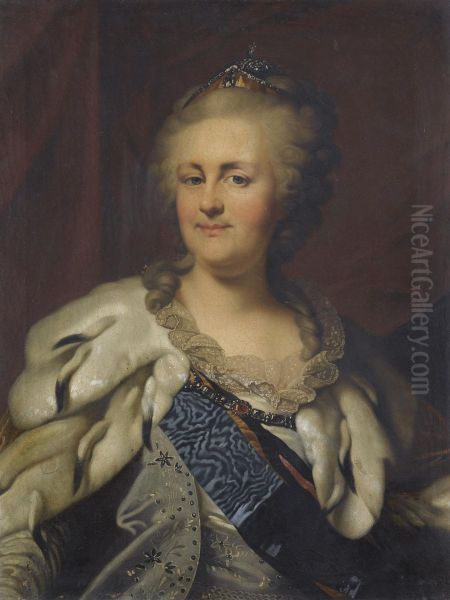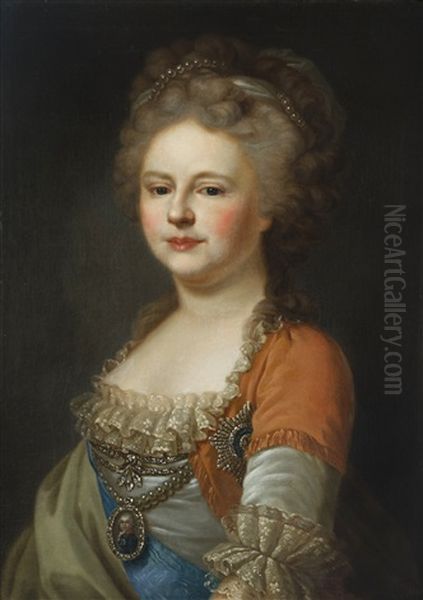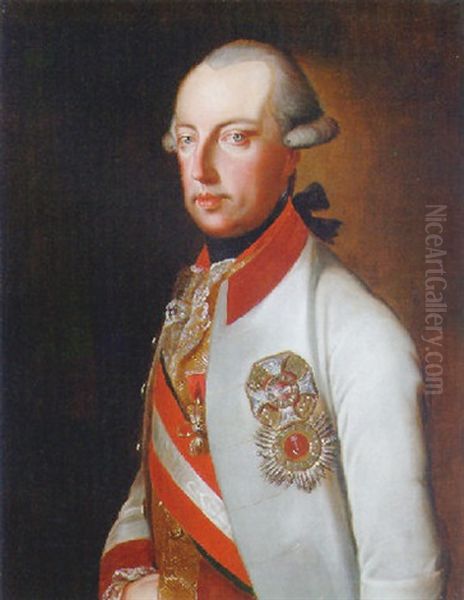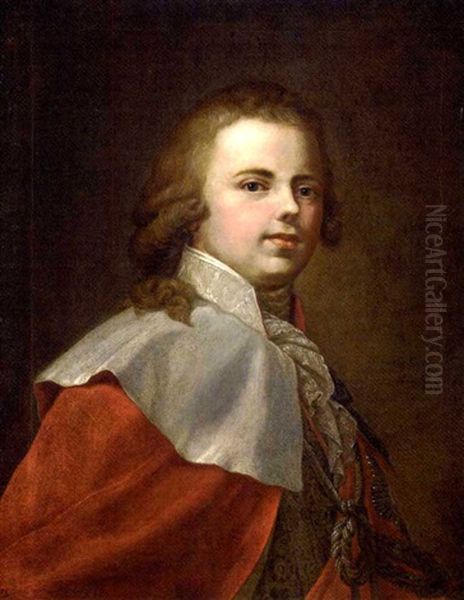Johann Baptist Lampi the Elder stands as a significant figure in late 18th and early 19th-century European art. An accomplished painter primarily celebrated for his sophisticated portraiture, Lampi navigated the shifting artistic currents from late Rococo to Neoclassicism, leaving an indelible mark on the courts of Austria, Poland, and Russia. His technical skill, combined with an ability to capture the likeness and status of his sitters, made him one of the most sought-after portraitists of his time.
Origins and Artistic Formation
Born on December 31, 1751, in Romeno, a village in the Val di Non near Trento, then part of the Prince-Bishopric of Trento within the Holy Roman Empire (now Italy), Johann Baptist Lampi entered a world where artistic patronage was flourishing. His father, Mattia Lampi (also spelled Matthias Lamp), was a decorative painter, providing an early exposure to the arts. This familial connection likely nurtured his burgeoning talent and set him on a path toward a creative career.
His formal artistic education began in Verona, where he studied under Francesco Lorenzi, a painter influenced by the Venetian master Giambattista Tiepolo. This training would have immersed the young Lampi in the rich colours and dynamic compositions characteristic of the Italian tradition. Further studies likely took place in Trento, deepening his technical foundation and understanding of contemporary artistic trends. His Italian roots and training provided a crucial base upon which his distinct style would later be built.
Ascendancy in Vienna
Seeking broader opportunities, Lampi moved to Vienna, the vibrant capital of the Habsburg Empire. He enrolled in the prestigious Academy of Fine Arts (Akademie der bildenden Künste Wien), a centre of artistic learning and innovation. Vienna, under the rule of Empress Maria Theresa and later her son Joseph II, was a hub of culture and enlightenment, attracting artists from across Europe. Here, Lampi honed his skills, likely studying the works of established court painters like Martin van Meytens and absorbing the prevailing artistic tastes.

Lampi's talent did not go unnoticed. He quickly gained recognition for his abilities, particularly in portraiture. His work demonstrated a refined technique, an eye for detail, and a flattering, yet insightful, portrayal of his subjects. This success culminated in a significant early achievement: in 1776, at the young age of 25, he was appointed a professor at the Vienna Academy. This position not only provided stability but also cemented his reputation within the Austrian art world. He became known for both his portraits and historical paintings, contributing to the city's rich artistic milieu alongside contemporaries like the great fresco painter Franz Anton Maulbertsch.
Court Painter in Warsaw
Lampi's growing fame transcended Austrian borders. In the late 1780s, his career took a significant international turn when he attracted the attention of Stanisław August Poniatowski, the last King of Poland. A renowned patron of the arts and sciences, Stanisław August presided over a culturally brilliant court in Warsaw, despite the increasingly precarious political situation of the Polish-Lithuanian Commonwealth. He invited Lampi to Warsaw, where the artist worked from approximately 1787 or 1788 until 1791.
During his time in Poland, Lampi served as a court painter, producing numerous portraits of the King, his family, and members of the Polish aristocracy. His celebrated Portrait of King Stanisław August Poniatowski exemplifies his work from this period, capturing the monarch's enlightened persona and regal bearing. Lampi worked alongside other artists favoured by the King, such as the Italian painters Marcello Bacciarelli, who was the King's principal painter, and Bernardo Bellotto (Canaletto's nephew), known for his detailed views of Warsaw. Lampi's elegant style resonated well with the sophisticated tastes of the Polish court.
However, this period was overshadowed by the looming partitions of Poland. The political instability ultimately influenced Lampi's decision to seek opportunities elsewhere, marking the end of his Polish chapter but paving the way for an even more prestigious appointment.
Imperial Service in St. Petersburg
In 1791, Lampi received a highly coveted invitation from Empress Catherine the Great of Russia. Catherine, an avid art collector and patron, was transforming St. Petersburg into a major European cultural capital. She sought talented artists to glorify her reign and portray the Russian imperial family and nobility. Lampi accepted the invitation and moved to St. Petersburg, embarking on the most illustrious phase of his career.

He quickly became a favourite at the Russian court. His ability to combine formal dignity with a sense of individual character appealed greatly to his imperial and aristocratic patrons. He painted numerous portraits of Catherine the Great herself, perhaps the most famous being the one where she is depicted standing, often interpreted as representing her role as a wise ruler and "Mother of the Land," a departure from purely absolutist imagery sometimes seen in Rococo portraiture. This work showcases his mature style, blending Rococo grace with Neoclassical clarity.
Lampi remained in Russia for several years, working through the end of Catherine's reign (d. 1796) and into the reigns of her successors, Paul I and Alexander I. He painted Empress Maria Feodorovna (Sophie Dorothea of Württemberg, Paul I's wife), Grand Dukes, and prominent figures like Prince Grigory Potemkin-Tavricheski, Catherine's influential favourite. His presence in St. Petersburg significantly impacted the development of Russian portraiture.
Influence on Russian Art
During his tenure in Russia, Lampi not only produced a prolific body of work but also played a role in shaping the next generation of Russian artists. He was associated with the Imperial Academy of Arts in St. Petersburg and influenced several local painters. Most notably, he is credited with having taught or significantly influenced Vladimir Lukich Borovikovsky, who became one of Russia's leading portraitists, known for his sentimental and elegant style.
Lampi's sophisticated technique, particularly his smooth finish, delicate modelling of features, and attention to the textures of fabrics and jewels, provided a compelling model for Russian artists seeking to emulate European standards. While Russia already had established portraitists like Dmitry Levitzky, Lampi's international prestige and fashionable style brought a fresh wave of influence, contributing to the refinement of portrait painting in the empire during the late 18th and early 19th centuries. His works were widely admired and sometimes copied, further disseminating his style.
Artistic Style: Bridging Rococo and Neoclassicism
Johann Baptist Lampi the Elder's artistic style is often characterized as a transition between the late Rococo and the emerging Neoclassical movement. His work retains the elegance, grace, and attention to luxurious detail associated with the Rococo, evident in his handling of rich fabrics, intricate lace, and gleaming jewels. He employed a harmonious colour palette and often depicted his subjects with a sense of charm and poise.

However, Lampi's portraits also incorporate elements of Neoclassicism, which gained prominence during his lifetime. This is visible in the clarity of composition, the relatively restrained poses compared to high Rococo exuberance, and the emphasis on accurate, individualized likeness rather than idealized types. He achieved a remarkable naturalism in capturing the sitter's features and, often, a sense of their psychological presence. His brushwork was typically smooth and refined, creating a polished surface that enhanced the realism and dignity of the portrayal.
Compared to the more overtly emotional or dramatic Neoclassicism of artists like Jacques-Louis David in France, Lampi's style was gentler, more focused on social grace and status. His approach found parallels in the work of other successful European portraitists of the era, such as Élisabeth Vigée Le Brun, who also worked for several European courts, including Russia, and Angelica Kauffman, another prominent female artist known for her Neoclassical portraits and history paintings. While distinct from the looser, more atmospheric brushwork of British contemporaries like Thomas Gainsborough or the grand manner of Sir Joshua Reynolds, Lampi shared their goal of elevating portraiture through technical mastery and insightful characterization. His work can also be seen in dialogue with the Neoclassical ideals promoted by theorists and painters like Anton Raphael Mengs.
Masterworks and Their Significance
Several portraits stand out as representative of Lampi the Elder's skill and historical importance:
Portrait of Catherine the Great (c. 1790s): As mentioned, this iconic image, existing in several versions, captures the Empress in her later years. It balances imperial authority with a certain approachability, reflecting Catherine's cultivated image as an enlightened monarch. Its blend of stately presence and detailed realism makes it a key work of late 18th-century Russian court portraiture. It is housed in institutions like the Hermitage Museum and the Kunsthistorisches Museum.
Portrait of King Stanisław August Poniatowski (c. 1788-89): This portrait, often depicted with the King in his coronation robes or with symbols of the Polish-Lithuanian Commonwealth, showcases Lampi's ability to convey majesty and intellect. It serves as a poignant record of the last Polish king, a significant figure of the European Enlightenment, painted during a critical period in Polish history. Examples are found in Polish collections, including the Royal Castle in Warsaw.
Portrait of Empress Maria Feodorovna: Lampi painted Paul I's wife multiple times. These portraits emphasize her elegance, refinement, and role as consort. They are fine examples of his skill in rendering textures, particularly silks and pearls, and capturing a sense of serene dignity, characteristic of female portraiture of the period.

Portrait of Prince Grigory Potemkin-Tavricheski (c. 1790): Painted shortly before Potemkin's death, this work captures the powerful statesman and military leader. Lampi conveys Potemkin's formidable personality and high status through pose, attire, and expression. This portrait is held in the Hermitage Museum.
Portrait of Prince Johann I Joseph of Liechtenstein (c. 1805-06): Painted after Lampi's return to Vienna, this work shows his continued engagement with high-ranking patrons. It depicts the Austrian field marshal and head of the princely house, showcasing Lampi's mature style. This work highlights the demand for his portraits among the Austrian nobility.
These works, among many others, demonstrate Lampi's consistent quality and his role as a visual chronicler of European royalty and aristocracy during a transformative era.
Later Life, Family, and Legacy
Although sources sometimes differ on the exact dates, Lampi appears to have left St. Petersburg around 1797 or 1798, returning to Vienna. He had achieved immense success and financial security through his Russian commissions. In Vienna, he resumed his position at the Academy and continued to receive prestigious commissions from the Austrian nobility and bourgeoisie. In recognition of his achievements, he was ennobled in 1798 by Emperor Francis II, allowing him to use the predicate "von Lampi."
Johann Baptist von Lampi the Elder passed away in Vienna on February 11, 1830. He left behind a significant artistic legacy, not only through his own extensive oeuvre but also through his sons, who followed in his footsteps. Johann Baptist Lampi the Younger (1775–1837) also became a successful portrait painter, working in St. Petersburg and Vienna, sometimes leading to confusion between their works. Another son, Franz Xaver Lampi (1782–1852), specialized primarily in portraiture and genre scenes, working mainly in Warsaw.
Lampi the Elder's influence persisted, particularly in Central and Eastern Europe. His polished technique and elegant style set a standard for formal portraiture that resonated well into the 19th century. His ability to adapt to the changing tastes, moving from Rococo sensibilities towards Neoclassical clarity, ensured his relevance throughout a long and productive career.
Contemporaries and Context: Canova and Goya
When considering Lampi's place in European art, it's natural to think of other giants of the era. Two prominent contemporaries were the Italian sculptor Antonio Canova (1757-1822), the leading exponent of Neoclassical sculpture, and the Spanish painter Francisco Goya (1746-1828), a unique master whose work spanned Rococo, Neoclassicism, and Romanticism, often with searing social commentary.
While Lampi, Canova, and Goya were all active during the same period and catered to elite patrons across Europe, there is no documented evidence of direct personal interaction, correspondence, or artistic collaboration between Lampi and either Canova or Goya. Their paths, while sometimes geographically close (Canova also worked for patrons in Vienna and St. Petersburg), do not appear to have crossed in a meaningful way recorded by history. Lampi's focus remained largely within the established conventions of courtly portraiture, whereas Canova redefined sculpture with his idealized forms, and Goya explored darker, more expressive, and critical themes, especially in his later work. Placing Lampi alongside them highlights the diversity of artistic practice at the turn of the 19th century.
Anecdotes, Attribution, and Collections
Like many successful artists with busy studios, questions of attribution sometimes arise regarding works associated with Lampi the Elder. Distinguishing his hand from that of his sons or studio assistants can occasionally be challenging for art historians. Furthermore, the political turbulence of the era directly impacted his career, necessitating his moves from Warsaw to St. Petersburg and eventually back to Vienna.
Intriguing stories sometimes surround the famous figures Lampi painted. For instance, various sensational rumors circulated about Catherine the Great's private life, including apocryphal tales like the infamous horse story. While these lurid anecdotes relate to Lampi's most famous sitter, they are part of Catherine's mythology and not directly connected to the artist himself, though they form part of the colourful historical backdrop against which he worked.
Today, Johann Baptist Lampi the Elder's works are held in major museums across Europe, including the Kunsthistorisches Museum in Vienna, the Hermitage Museum in St. Petersburg, the State Russian Museum in St. Petersburg, the Royal Castle in Warsaw, the National Museum in Warsaw, and numerous other public and private collections. His paintings continue to be featured in exhibitions dedicated to 18th-century art, European portraiture, and the cultural history of the courts he served. Recently, works previously unattributed or misattributed have been identified as his, such as a classical portrait of a woman holding a dove rediscovered by the Alte Kunst Fine Art Gallery in Vienna, underscoring ongoing scholarly interest in his oeuvre.
Conclusion: A Pan-European Portraitist
Johann Baptist Lampi the Elder was more than just a skilled painter; he was a quintessential European artist of his time. Born Italian, rising to prominence in Austria, serving the Polish King, and reaching the zenith of his fame in Imperial Russia, his career reflects the interconnectedness of European culture and patronage in the late Enlightenment era. His art skillfully navigated the transition from the decorative elegance of the Rococo to the structured clarity of Neoclassicism, always prioritizing the refined portrayal of his distinguished sitters.
Through his prolific output, Lampi provided a visual record of the ruling elites of Central and Eastern Europe during a period of profound political and social change. His technical mastery, his ability to convey both status and individuality, and his lasting influence on portraiture, particularly in Russia, secure his position as a significant master in the history of European art. His legacy endures in the numerous portraits that grace museum walls, offering compelling glimpses into the faces and fashions of a bygone aristocratic world.